Doctors prescribe time outdoors to boost mental and physical health


Call it a new kind of medical advice: find a shady tree, breathe deeply and check back tomorrow.
Healthcare providers in the United States have long encouraged patients to spend more time outside. Now, hundreds of them are formalizing that guidance by issuing prescriptions for nature outings, as stress fueled by social media, politics and global conflict continues to weigh on Americans.
No one needs a doctor’s note to step outdoors, but some practitioners say the written prescription helps people treat the advice as a priority rather than a luxury.
“When I bring it up, it’s almost like granting permission to do something they may think is frivolous at a time when everything feels serious and stressful,” said Dr. Suzanne Hackenmiller, a gynecologist from Waterloo, Iowa. She began prescribing nature after finding comfort outside following her husband’s death.
Research shows benefits in nature
Studies have consistently found that time in natural environments can lower blood pressure, reduce stress hormones and strengthen the immune system.
“Study after study says we’re wired to be out in nature,” said Dr. Brent Bauer, director of the Mayo Clinic’s complementary and integrative medicine program in Minnesota. The program explores treatments such as meditation, massage, acupuncture and nutrition. “There’s real science behind it.”
Making the advice stick
Turning suggestions into prescriptions began gaining momentum around a decade ago. Dr. Robert Zarr, also a certified nature guide, founded Park Rx America in 2016 to help doctors incorporate outdoor time into treatment plans.
The group’s guidelines encourage providers to discuss a patient’s interests, how often they can get outdoors and nearby parks to visit. The details are written into a prescription, and patients receive reminders.
Nearly 2,000 providers worldwide have joined Park Rx America, including in Australia, Brazil, Cameroon and Spain, and more than 7,000 nature prescriptions have been issued since 2019, said Dr. Stacy Beller Stryer, the group’s associate medical director. About 100 similar programs have emerged in the U.S.
For some, the prescription itself is motivation. Bauer, who treats business executives, said he writes about 30 nature prescriptions each year.
“When someone hands me a piece of paper telling me to take a medication, I’m more likely to act on it,” he said. “The same idea works here.”
Nature as a refuge
Hackenmiller said more patients are searching for breaks from a world filled with constant crisis.
“When so many things are out of our control, it can help to step away from the media and immerse ourselves in nature,” she said. “People often reconnect with moments when nature brought them comfort before.”
Measuring impact still underway
A 2020 study by the U.S. Forest Service and researchers from two universities found more research is needed to assess how often patients follow through and what long-term health results emerge. Still, experts agree that getting outdoors is beneficial unless conditions like smoke or insects pose a hazard.
At William & Mary in Virginia, students prescribe outdoor time to fellow students through an online system. Applicants list when they can go outside, how far they’re willing to travel and what activities they enjoy. The program issued an average of 22 prescriptions per month in 2025, up from 12 in 2020.
Senior Kelsey Wakiyama, from Villanova, Pennsylvania, said she relied on nature prescriptions after arriving on campus and not knowing the local trails.
“I love the greenery,” she said. “When you’re indoors for hours, the fresh air feels incredible. It calms my nervous system and brings back good memories.”
Source: AP
